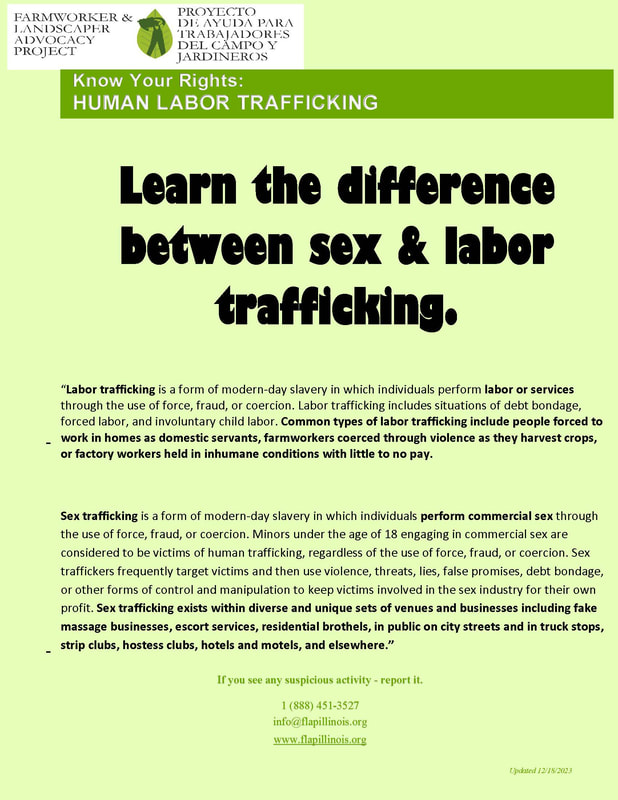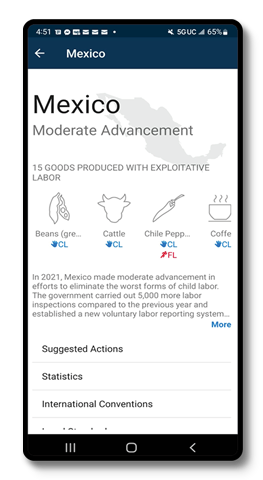Migration is not a new concept and has been occurring throughout the world for many years. Migration can be voluntary or involuntary and can occur for a variety of different reasons. Some of these reasons include economic, environmental, and social issues. In the United States, we are always hearing about migrants crossing over the border to seek out a new life and new opportunities. To be more specific, this post will be talking about Illinois and the city of Chicago to give you a relation to what’s happening in our own back yard. It is also important to understand that while numbers will be used for prevalence, this is not 100% accurate as there are cases that go unreported.
Labor trafficking is a form of modern-day slavery in which individuals perform labor or services through the use of force, fraud, or coercion. Labor trafficking includes situations of debt bondage, forced labor, and involuntary child labor. Common types of labor trafficking include people forced to work in homes as domestic servants, farmworkers coerced through violence as they harvest crops, or factory workers held in inhumane conditions with little to no pay. Source: https://humantraffickinghotline.org/en/human-trafficking/sex-trafficking Sweat & Toil: Child Labor, Forced Labor, and Human Trafficking Around the World is a comprehensive resource developed by ILAB documenting child labor and forced labor worldwide. Data and research in this app are taken from ILAB's three flagship reports: Findings on the Worst Forms of Child Labor; List of Goods Produced by Child Labor or Forced Labor; and List of Products Produced by Forced or Indentured Child Labor. This app fits these three information-packed reports the size of a phone book in the palm of your hand. Seven things you can do with this app are:
Download the iPhone app or download the Android app and see what can you do to help. Read more from the DOL at https://www.dol.gov/general/apps/ilab www.dol.gov/general/apps/ilab January is National Human Trafficking Prevention Month and a time for everyone to come together to raise awareness of and help combat this heinous crime. January 11 marks National Human Trafficking Awareness Day, also known as #WearBlueDay. On this day, Blue Campaign invites you to:
Wear blue, the international color of human trafficking awareness, to state your commitment to help save lives. Need inspiration? See how others have participated in previous years. Post a photo of yourself, or with others, on social media using the hashtag #WearBlueDay. You can also download ready-to-use #WearBlueDay graphics and captions to post on your social channels to spread the word. Empower others in your community to do the same. Follow @DHSBlueCampaign on Facebook, Twitter, and Instagram and visit DHS.gov/Blue-Campaign/WearBlueDay for more information about #WearBlueDay, upcoming events, and other anti-human trafficking efforts in January and throughout the year. Myth: All human trafficking involves commercial sex Reality: Human trafficking is the use of force, fraud or coercion to get another person to provide labor or commercial sex. Worldwide, experts believe there are more situations of labor trafficking than of sex trafficking. However, there is much wider awareness of sex trafficking in the United States than of labor trafficking. Myth: Human trafficking only happens in illegal or underground industries Reality: Human trafficking cases have been reported and prosecuted in industries including restaurants, cleaning services, construction, factories and more. Myth: If the trafficked person consented to be in their initial situation, then it cannot be human trafficking or against their will because they “knew better” Reality: Initial consent to commercial sex or a labor setting prior to acts of force, fraud, or coercion (or if the victim is a minor in a sex trafficking situation) is not relevant to the crime, nor is payment. Source: Myths & Facts | National Human Trafficking Hotline Numerous myths and misconceptions exist when talking about human trafficking. Many of these myths attempt to explain what human trafficking is and who it impacts. When in reality, human trafficking is much more complex, and happening in plain sight. Myth #1: Only women and girls can be victims and survivors of human trafficking. Fact: One study estimates that 50% of individuals affected by sex trafficking are male. Advocates argue that percentage may be even higher but that male victims are far less likely to be identified. LGBTQ boys and young men are particularly vulnerable to trafficking. Myth #2: Traffickers target victims they do not know. Fact: Many survivors have been trafficked by romantic partners, including spouses, and by family members, including parents. Myth #3: Human trafficking involves moving or transporting a person across state or national borders. Fact: Human trafficking is frequently confused with human smuggling, which involves illegal border crossings. The crime of human trafficking does not require any movement whatsoever. Survivors can be recruited and trafficked in their own home towns, even their own homes. Source: Myths & Facts - National Human Trafficking Hotline https://humantraffickinghotline.org/en/human-trafficking/myths-facts Author: Ciara Sheeran, Stop-It Program Persons with developmental disabilities are at increased risk of human trafficking. There are many factors contributing to this risk including higher rates of unemployment, low payment for work, increased likely of social isolation, and decreased likelihood of receiving appropriate education about healthy relationships, sexuality, and relationship safety skills. The National Human Trafficking and Disabilities Working Group (NHTDWG) offers on-demand training and education, consultation, and resources around the intersection of human trafficking and disabilities. For NHTDWG reports, past trainings, and educational materials on the intersection of human trafficking and disabilities or for on demand training and information on how to request a speaker for your event, please visit - iofa.org/national-trafficking-disabilities-working-group/. Author: Dr. Frederika C. Theus, Licensed Clinical Psycholoist (Adapted from Welcome to the Internet: Online Safety from Love146) The internet is a great place. It is where we find funny dog videos, new recipes, and keep in touch with that one person from middle school that we kinda-maybe remember. The internet lets us connect with lots of people, but it is important to remember that interacting with people online can get complicated. Here are some helpful tips and tricks to keep yourself safe from online creepers: 1. DON'T TRUST THE DEFAULT PRIVACY SETTINGS Think of it this way: When you’re hanging out online it’s like being in your own room. But if you want privacy in your room, you can shut your door. Unfortunately, most websites, social media apps, or gaming devices come to you with the door wide open so that anybody, even creeps, can chat with you. (Worst of all, sometimes it’s almost impossible to tell that they’re creeps.) But you can take steps to help keep them out. Most of these websites, apps, and games have settings that allow you to shut the door. You just need to change your privacy settings so that only your real friends can connect with you. If you need help learning how to do this, here’s a page with quick links to the privacy settings pages for common apps, websites, and gaming devices. 2. HAVE AN EXIT PLAN If someone is bugging you or talking to you in a way you don’t like, you can unfriend or block them, and you shouldn’t hesitate to! (Report them through the app, too, if something is getting really sketchy). If you’re talking to or being followed by people who aren’t your close friends, avoid posting things that reveal how to find you in real life (like the name of your school, where your soccer team practices, etc). It could also be smart to make sure that your user name or handle is different from your real name, that way if you get into a conversation that’s making you uncomfortable you can exit it without the fear of someone tracking you down. 3. BE A TINY BIT PARANOID If you send or post a picture, you can’t always control how it’s being seen—or how it’s being shared by others. If you feel like there’s any chance that the picture could get into the wrong hands, don’t risk it, don’t share or post it. 4. STAY IN SAFE ONLINE PLACES Just as you wouldn’t walk down dark alleys alone at night, you should avoid creepy places online and creepy apps. You could stumble on photos or videos you don’t want to see (or maybe are even illegal!), or end up connecting with people who are looking to take advantage of you. Follow your gut, and don’t walk down the alleyways of the Internet. 5. TELL SOMEONE If you ever feel uncomfortable or think that something is sketchy, tell an adult you trust! Whether it’s a teacher, a parent or a school counsellor. It’s better to talk to someone about it now, even if it means you have to confess something you did or it’s difficult to share. If you wait it could become a bigger problem. If you’d like, you can also talk to someone anonymously by calling the CyberTipline at 1-800-843-5678. How do you know when someone has bad intentions or is just being really friendly? Click this link for the full article with red flag phrases, more tips, and lots of memes: https://love146.org/online-safety/ Author: Anna Pastor, CCHTTF Myth: Human Trafficking is a violent crime that almost always leaves victims/survivors with physical injuries. Author: Chenel Vanden Berk, BS, JD, RN, SANE-A,SANE-P Author: Nora Coghlan, The Salvation Army STOP-IT program Each year, the Combat Human Trafficking Act of 2015 requires that the Bureau of Justice Statistics (BJS) prepares a report on human trafficking. This past October, BJS released information on the data collection profile. This report provided valuable information on characteristics of human trafficking defendants in cases charged in US district courts in the fiscal year 2021. These stats included that most defendants of peonage, slavery, forced labor and sex trafficking were Black males between the ages of 25-34, with 76.6% of defendants being male, 57.5% of defendants being Black, and 38.3% of defendants being between the ages of 25-34. Read more about the statistics released here: https://bjs.ojp.gov/document/htdca23.pdf .
Welcome - we are so glad you are here!
The History Behind the Month, National Human Trafficking Prevention Month Factsheet, U.S. Department of State
|
NHTAM 2024ArchivesCategories |
||||||


 RSS Feed
RSS Feed